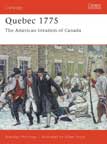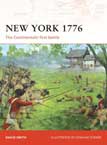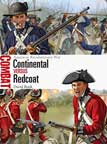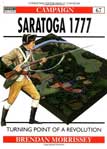

Ending with the fall of the capital city to the British Army, the campaign for Philadelphia set in motion a series of events, that led to the defeat of the British and eventual independence for the emerging American nation.
From the landing of Howe's army at the head of the Elk River in Maryland, to his eventual capture of Philadelphia, the campaign included some fascinating battles. The first engagement at Brandywine, the inconclusive battle of the Clouds, the controversial Paoli Massacre, the missed opportunity at Germantown, and the maturing of an army at Valley Forge, are all examined in detail by Justin Clement, with supporting maps, original artwork, and photographs.
Recently discovered information about the battle of Brandywine and analysis of the major personalities involved, completes this comprehensive account of an important episode in the American War of Independence (1775-1783).
Osprey's Campaign title for the Siege of Yorktown (1781), which was part of the American Revolutionary War (1775-1783). By 1781 Britain's struggle to contain the rebels in her American colonies had reached an inglorious stalemate. Six years on from the British defeat by the New England militia at Boston, George Washington's rebuilt Continental Army - with support from the French - now systematically began to seek out and destroy British forces even if protected by seemingly impregnable defences. Yorktown would be a salutary lesson to the British Crown about the odds she now faced in holding on to her colonies.
Osprey's examination of the COntinentals' first battle of the American Revolutionary War (1775-1783). General Sir William Howe's NewYork campaign gave the British their best chance of destroying the Continental Army and George Washington's resistance to colonial power. Having initially assembled his forces on Staten Island, Howe succeeded in dividing the Continentals, defeated them on Long Island and forced Washington to retreat to Brooklyn Heights. Under siege there Washington successfully extricated his troops and crossed the East River to Manhattan but soon had to fall back on Harlem Heights.
After a few weeks Howe forced the Continentals north to White Plains and defeated them again. However, he allowed Washington to withdraw and preserve his army when more aggressive pursuit could have brought the campaign to a decisive conclusion and ended the war. Instead, with the British army rapidly weakening and facing huge manpower shortages, Washington emerged from a succession of defeats to produce what was ultimately a war-winning strategy. The author provides fascinating insights into a unique campaign in which a string of British victories ultimately led to failure and defeat.
By the Spring of 1781, the American Revolutionary War (1775–1783) had dragged on for almost six years and the outcome still hung in the balance. When the British commander Lord Cornwallis launched his invasion of North Carolina in early 1781, his objective was to destroy General Nathaniel Greene’s American army. At Guilford Courthouse on 15 March 1781 the two armies met. In a desperately hard-fought battle the small but professional British army succeeded in fighting its way through three separate lines of American troops – but at a dreadful cost. Cornwallis lost over a quarter of his command. When news of the ‘victory’ reached Britain, a politician remarked; ‘Another such victory would ruin the British army’.
The British assault on Breed's Hill and the burning of Charlestown were the first major battles of the American Revolution; after the events at Boston there was no turning back. This detailed text by Brendan Morrissey explores the opposing commanders and forces involved, whilst describing how the sparks at Lexington and Concord ignited the smouldering resentment of the Colonists into the flame of a rebellion. Colonist militia were pitted against British Redcoats in a series of struggles which led the British to evacuate Boston and to George Washington taking command of the fledgling American army.
The battle of Monmouth Courthouse was not only the last major action in the Northern theater, it was also the longest and hardest-fought engagement of the entire Revolutionary War (1775-1783). When the British abandoned Philadelphia to return to New York City, American troops harassed their retreat. On the morning of 28 June 1778, General Lee, George Washington’s lieutenant, attacked the British rearguard but his attack went badly wrong. The British rearguard, now reinforced, threw Lee’s troops into a headlong retreat. Lee was relieved of his command and Washington’s Continentals then stood toe-to-toe with the British, bloodily repulsing a series of powerful attacks by crack troops.
In June 1775 the Continental Congress, leading the American rebellion against the British Crown, created the Continental Army to serve in the line of battle alongside militia and "Provincial" units. Although supply problems, issues with discipline, and poor training hampered the Continentals' effectiveness in combat, they were able to inflict a decisive defeat on the British at Yorktown. In contrast, the backbone of the British forces in North America were long-service regular infantrymen, serving for the most part in single-battalion regiments. They had earned a formidable reputation on Europe's battlefields during the Seven Years' War, but in fighting the French in North America during that conflict had already learned a great deal about the very different fighting conditions prevalent in the New World.
In a host of encounters ranging from skirmishes to decisive pitched battles, the infantrymen of both sides would be tested to the limit, with supply problems, hostile terrain, and poor weather all adding to the horrors of close-quarter combat. Featuring full-color artwork, specially drawn maps, and archive illustrations, this engaging study offers key insights into the tactics, leadership, combat performance, and subsequent reputations of six representative Continental and Redcoat infantry regiments pitched into three pivotal actions that shaped the outcome of the American Revolutionary War.
Following the battle of White River and the fall of Forts Washington and Lee during the American Revolutionary War (1775-1783), George Washington withdrew his army, crossing the Delaware River to regroup. However, with morale at a critical low and the terms of enlistment of many of his troops set to expire, Washington decided on one more strike before the winter weather made military operations impossible. Re-crossing the Delaware on Christmas night, 1776, Washington's army surprised the Hessian garrison at Trenton and managed to kill, wound or capture 1,000 of the enemy for the loss of only four men. Then, avoiding a major engagement with the British Army under General Cornwallis that had been sent to track him down, Washington attacked and defeated another small British force at Princeton. Having inflicted two costly and embarrassing defeats on the British forces, Washington withdrew his army into winter quarters at Morristown.
Using a combination of modern photographs and period artwork, this book tells the story of the legendary campaign that restored the morale of American forces, caused the British to abandon large parts of New Jersey, and established General George Washington's reputation as a daring military strategist.
Osprey's examination of the Saratoga campaign, which was a watershed, and is widely believed to have been the turning point of the American War of Independence (1775-1783). For the first time British regulars were beaten in open battle by equal numbers of Americans. The Continentals bore the brunt of the fighting, supported by 'hordes' of militia who proved adept at attacking detachments or lines of communication.The after-shock in America (on both sides) and Europe transformed a civil war into a global struggle against the two colonial superpowers of the day, France and Spain, and eventually lost George III his American colonies.
The Americans did not simply outlast the British in the Revolutionary War, contends this author in a groundbreaking study, but won their independence by employing superior strategies, tactics, and leadership. Designed for the "armchair strategist" with dozens of detailed maps and illustrations, here is a blow-by-blow analysis of the men, commanders, and weaponry used in the famous battles of Bunker Hill, Quebec, Trenton, Princeton, Saratoga, and Cowpens.
Pope Julius II excommunicates Italian state of Venice
Treaty of St. Truiden: anti-French Trapdoors / Bourgondisch covenant
Battle at Bicacca: Charles I and Pope Adrianus VI beat France
Mogol King Babur beats Sultan of Delhi
1st Spanish settlement in Philippines, Cebu City, forms
Peace of Beaulieu and Paix de Monsieur
King Charles I flees Oxford
Scottish general Montrose defeated
Netherlands and France sign military covenant
Frederik August I "the Strong" becomes Monarch of Saksen
Battle at Culloden Moor: Duke of Cumberland beats "James VIII & III"
US Marines attack shores of Tripoli
Americans under General Pike capture Toronto; Pike is killed
Fire destroys half of Charleston
Imakita Kosen, 1st Zen teacher of D.T. Suzuki, found the awakening
Establishment of Jewish congregations in Lower Austria prohibited
"Pomona" sinks in North Atlantic drowning all 400 aboard
Thomas J Jackson is assigned to command Harpers Ferry
President Abe Lincoln suspends writ of habeas corpus
West Virginia secedes from Virginia after Virginia secedes from US
Cornell University (Ithaca NY) is chartered
Heinrich Schliemann discovers Troi
White League, Paramilitary white supremacist organization, forms
Opera "Le Roi de Lahore" is produced (Paris)
President Hayes removes Federal troops from LA, Reconstruction ends
Pogroms against Russian Jews start in Elisabethgrad
1st Highlander (Yankee) shut-out, Philadelphia Athletics win 6-0
World Exposition opens in Luik
Sultan of Turkey Abdul Hamid II is overthrown
Belgian parliament rejects socialist motion for general voting rights
Relief laws replaces those of 1854, in the Netherlands
Pogrom leader Petljoera declares Ukraine Independence
Hadjememaar, [Corn de Gelder] elected in Amsterdam
Fritz Langs "Dr Mabuse, der Spieler" premieres in Berlin
Yakut ASSR formed in Russian SFSR
Mussolini government italian place in South Tirol / Alto Adige
Antwerp soccer tie Belgium-Netherlands 1-1
Karl Jansky reports reception of cosmic radio signal in Washington DC
Yanks pull a 1st inning triple-play and beat Philadelphia Athletics 9-8
1st US social security payment made
US Social Security system makes its 1st benefit payment
Himmler orders establishment of Auschwitz Concentration Camp
German troops occupy Athens Greece
Belgium Jews are forced to wear stars
Tornado destroys Pryor Oklahoma killing 100, injuring 300
Lou Jansen and Jan Dieters arrested, lead illegal CPN party in Holland
Soviet Union breaks contact with Polish government exiled in London
Boston Brave Jim Tobin no-hits Brooklyn Dodgers, 2-0
2nd Republic of Austria forms
Italian partisans capture Mussolini prisoner
US 5th army enters Genua
1st radar installation aboard a coml ship installed
Babe Ruth Day celebrated at Yankee Stadium and through out US
Arab legion attacks Gesher bridge on Jordan River
"Tickets, Please" opens at Coronet Theater NYC for 245 performances
South Africa passes Group Areas Act segregating races
Mohammed Mossadeq chosen Premier of Persia
"4 Saints in 3 Acts" closes at Broadway Theater NYC after 15 performances
1st general elections in British Guyana, won by Jagans PPP
Wrestler Freddie Blassie coins term "Pencil neck geek"
Heavyweight champ, Rocky Marciano, retires undefeated from boxing
"Today" show goes abroard 1st time (Paris France)
Liu Sjau-chi elected President of China PR
1st atomic powered electric-drive submarine launched (Tullibee)
South Korean President Syngman Rhee resigns
Togo (formerly French Togo) declares independence from French adm
NASA launches Explorer 11 into Earth orbit to study gamma rays
NFL officially recognizes Hall of Fame in Canton, Ohio
Sierra Leone declares independence from the UK
"Jopie" Pengel forms government in Suriname
Cuban Premier Fidel Castro arrives in Moscow
RC Duncan patents "Pampers" disposable diaper
Dmitri Shostakovitch completes his 2nd cello concert
Rocky Marciano retires as undefeated boxing champ
"Education of Hyman Kaplan" closes at Alvin NYC after 28 performances
Baltimore Oriole Tom Phoebus no-hits Boston, 6-0
Congress of Political Party Radicals (PPR) forms in the Netherlands
Carol Mann wins LPGA Raleigh Ladies Golf Invitational
Curt Flood resigns Senators after 13 games and departs for Denmark
Apollo 16 returns to Earth
New York City Mayor John Lindsey appeals that John Lennon not be deported
Kansas City Royal Steve Busby no-hits Detroit Tigers, 3-0
Pan Am 707 crashes into mountains of Bali, killing 107
Sandra Haynie wins LPGA Charity Golf Classic
"So Long 174th St" opens at Harkness Theater NYC for 16 performances
Arabic Monetary Fund established in Abu Dhabi
Bloody riots in Soweto South Africa
HCC, Hobby Computer Club, forms in the Netherlands
Accident at nuclear reactor Willow Island, W Virginia, kills 51
George Harrison releases "Love Comes to Everyone"
Barbara Barrow wins LPGA Birmingham Golf Classic
1st female soccer official is hired by NASL
Beatle Ringo Starr marries actress Barbara Bach [Goldbach]
Nordiques 1-Isles 4 - Semifinals - Isles hold 1-0 lead
Trial of John W Hinckley Jr attempted assassin of Reagan, begins
Nolan Ryan becomes strikeout King (3,509), passing Walter Johnson
Cleveland Indians beat Detroit Tigers, 8-4, in 19 innings
Over 70 inches of snow falls on Red Lake, Montana
"Sweet Charity" opens at Minskoff Theater NYC for 368 performances
Captain Midnight (John R MacDougall) interrupts HBO
Pat Bradley wins LPGA S&H Golf Classic
US Justice Department bars Austrian Chancellor Kurt Waldheim from entering US, due to his aid of Nazi Germany during WWII
"Starmites" opens at Criter Ctr SR Theater NYC for 60 performances
Beijing students take over Tiananmen Square in China
Hurricane in Bangladesh, kills 500
Mandatory seatbelt law goes into effect in Italy
50th annual barbershop quartet singing convention held (Mich)
Dodger Orel Hershiser undergoes career-threatening shoulder surgery
Firestone World Bowling Tournament of Champions won by David Ozio
"Small Family Business" opens at Music Box Theater NYC for 48 performances
New York Jets finish perfect 5-0 pre-season for 1st time
New York Mets trade David Cone to Toronto Blue Jays for Jeff Kent
Afghan Antonov AN-32 crashes at Tashqurgan, kills 76
"Inspector Calls" opens at Royale Theater NYC for 454 performances
7th longest NHL game: New Jersey Devils beat Buffalo Sabres (125 min 43 seconds)
Graeme Obree bicycles world record time (52,713 km)
President Nixon buried in Nixon Library in California
Twins righty Scott Erickson no-hits Brewers 6-0
"Indiscretions" opens at Ethel Barrymore Theater NYC for 221 performances
Coors Field in Colo opens - Denver Rockies beats Mets 11-9 in 14
"Little Foxes, " opens at Vivian Beaumont NYC for 56 performances
"Stanley, " closes at Circle in the Square Theater, New York City
Frank Nobilo wins Greater Greensboro Chrysler Classic at Forest Oaks
Las Vegas Senior Golf Classic by TruGreen-ChemLawn
Nancy Lopez wins LPGA Chick-fil-A Charity Championship










